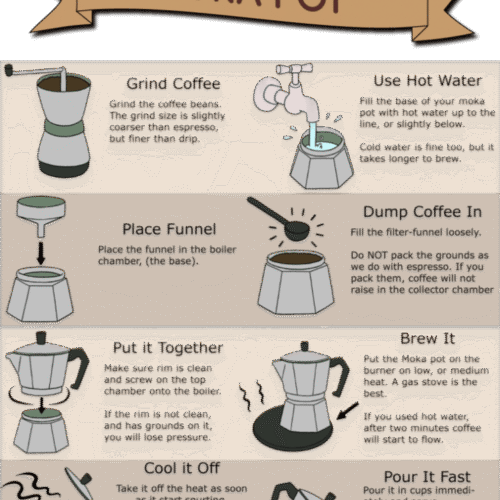To make Cuban coffee, add sugar to a cup and pour a few drops of espresso over the sugar. Whip the coffee and sugar together to create a slurry, then add the remaining espresso and stir.
Cuban coffee is known for its strong taste and dark look, made with demerara sugar for a unique sweetness.

Credit: www.pinterest.com
1. Gathering The Ingredients
Before diving into the delicious world of Cuban coffee, it’s important to gather all the necessary ingredients. Choosing the right coffee beans, selecting the ideal type of sugar, and preparing the necessary equipment are the key steps to start your flavorful journey.
Choosing The Right Coffee Beans
When it comes to making authentic Cuban coffee, the choice of coffee beans is vital. Traditionally, Cuban coffee is made using a dark roast blend, which imparts a rich and intense flavor to the brew. Look for coffee beans labeled as Cuban or espresso roast to achieve the desired taste. These beans are finely ground, ensuring proper extraction and concentration of flavors.
Selecting The Ideal Type Of Sugar
The sweetness of Cuban coffee comes from the type of sugar used. Demerara sugar, sometimes referred to as raw cane sugar, is the preferred choice for an authentic and unique Cuban coffee experience. Its distinctive dark color and rich flavor pair perfectly with the boldness of the coffee. Be sure to have this particular sugar on hand for an authentic Cuban coffee taste.
Preparing The Necessary Equipment
To make Cuban coffee, you’ll need a few essential equipment items:
- Espresso maker: A stovetop espresso maker, also known as a moka pot, is commonly used in Cuban households. This compact and easy-to-use apparatus helps extract the strong flavors necessary for a perfect cup of Cuban coffee.
- Measuring cup or creamer cup: This cup will be used to measure and mix the sugar with the first few drops of espresso.
Now that you have gathered the right coffee beans, sugar, and equipment, you are ready to start brewing your own delectable cup of Cuban coffee. Remember, the key to an authentic and flavorful Cuban coffee lies in the attention to detail and the love put into the process.
2. Preparing The Espresso
Now that you’ve ground the coffee beans to the perfect consistency, it’s time to move on to brewing the espresso. Cuban coffee, also known as Café Cubano, is traditionally made using a stovetop espresso maker. Here’s how you can prepare it:
Grinding The Coffee Beans To The Right Consistency
To ensure a flavorful and aromatic espresso, it’s crucial to grind the coffee beans to the right consistency. For Cuban coffee, you’ll need a fine grind, almost like powdered sugar. This allows for optimal extraction of the coffee’s flavors and ensures a strong and robust cup of espresso.
Brewing The Espresso Using A Stovetop Espresso Maker
To make authentic Cuban coffee, a stovetop espresso maker, also known as a moka pot, is the go-to tool. Here’s a step-by-step guide to brewing your espresso:
- Add water to the bottom chamber of the espresso maker, making sure not to exceed the safety line.
- Insert the funnel-shaped filter basket into the bottom chamber and fill it with the finely ground coffee. Level the coffee grounds, but avoid tamping them down.
- Screw the top chamber tightly onto the bottom chamber, ensuring a secure seal.
- Place the espresso maker on a stovetop burner set to medium heat.
- As the water heats up, it will start to create pressure, forcing the water through the coffee grounds and into the top chamber as espresso.
- Once you hear a hissing or bubbling sound, it’s an indication that the brewing process is almost complete.
- Remove the espresso maker from the heat source and let it sit for a moment to allow any remaining water to be drawn into the top chamber.
Now that you’ve successfully brewed the espresso, it’s time to move on to the next step and enjoy the rich flavors of Cuban coffee.
3. Adding Sugar To Create The Perfect Crema
To create the perfect crema in Cuban coffee, add sugar to your espresso shots. Start by adding a few drops of espresso into a cup of sugar, then mix until you create a paste. This technique adds sweetness and enhances the flavor of the coffee.
Understanding The Importance Of Sugar In Cuban Coffee
Sugar plays a critical role in creating the perfect crema for Cuban coffee. Traditionally, Cuban coffee is made using a raw type of brown sugar called demerara sugar. This distinct sugar gives Cuban coffee its signature sweetness and rich flavor. The demerara sugar is key to achieving the velvety texture and creamy foam, known as crema, that is a hallmark of Cuban coffee.
Mixing The Sugar And Espresso To Create A Creamy Texture
Once you have brewed your espresso, it’s time to mix the sugar and espresso to create that creamy texture. Here’s a step-by-step guide:
- In a measuring cup or creamer cup, add the demerara sugar. Add the first few drops of espresso from the espresso maker into the cup of sugar. This initial addition of espresso helps dissolve the sugar and create a thick paste.
- Using a spoon, vigorously mix the sugar and espresso together until it forms a smooth paste. Make sure to incorporate all the sugar granules into the espresso to ensure a consistent flavor throughout.
- Pour the remaining brewed espresso over the top of the sugar paste. This helps to dissolve any leftover sugar and creates a well-blended mixture.
- Stir the mixture well to ensure that the sugar is completely dissolved and thoroughly mixed with the espresso. This stirring action also helps to create a frothy crema on top of the coffee.
- Now, your Cuban coffee is ready to be enjoyed! Pour it into small espresso cups or shot glasses, and savor the rich, sweet flavors and creamy texture that make Cuban coffee so beloved.
By following these steps and ensuring that the sugar and espresso are well mixed, you’ll be able to create the perfect crema for your homemade Cuban coffee. Remember, the key is to use demerara sugar and to mix it thoroughly with the espresso. This will result in a deliciously balanced and sweet cup of Cuban coffee that’s sure to delight your taste buds.
4. Serving And Enjoying Cuban Coffee
Now that you have successfully prepared a delicious cup of Cuban coffee, it’s time to savor the rich flavors and enjoy the true essence of this iconic beverage. Serving and enjoying Cuban coffee is a delightful and satisfying experience that allows you to appreciate the unique blend of espresso and sugar. Here’s how you can make the most of your Cuban coffee:
Pouring The Espresso Into Small Cups
When it comes to serving Cuban coffee, tradition plays a significant role. Cuban coffee is typically served in small cups called “tacitas,” which are designed to accentuate the flavors and intensity of the coffee. These cups are usually made of ceramic or porcelain and are smaller than regular coffee mugs.
To serve your Cuban coffee, grab your small cups and pour the freshly brewed espresso into them. The strong aroma of the coffee will fill the air, preparing your senses for the rich flavors to come. Make sure to pour slowly and evenly to avoid any spills or wasted coffee.
If you’re hosting a gathering or sharing the experience with others, consider placing a decorative saucer under each cup for an added touch of elegance. This will not only protect your surfaces but also enhance the overall presentation of the coffee.
Savoring The Rich Flavors Of Cuban Coffee
Now that your cups are filled with delicious Cuban coffee, it’s time to savor each sip and fully appreciate the unique taste. Cuban coffee is known for its robust and bold flavors, thanks to the combination of espresso and demerara sugar.
Start by lifting your cup and bringing it close to your nose. Take a moment to inhale the intoxicating aroma and let it awaken your senses. The scent alone will give you a glimpse of the flavors to come.
When tasting Cuban coffee, let it gently glide over your palate, allowing the flavors to dance on your taste buds. Experience the harmonious blend of intense espresso and the natural sweetness of demerara sugar. Notice the slight bitterness of the coffee, balanced perfectly by the rich sweetness.
To fully appreciate the flavors, take small, deliberate sips rather than gulps. This will allow the coffee to linger in your mouth and intensify the taste experience. Observe how the flavors evolve as the coffee warms your mouth and leaves a lingering, satisfying finish.
Remember, enjoying Cuban coffee is not only about the flavors but also about the experience itself. Take your time, relax, and immerse yourself in the moment. Share this traditional beverage with friends and loved ones, and let the warmth and richness of Cuban coffee envelop you.
5. Variations And Tips For Making Cuban Coffee
When it comes to enjoying Cuban coffee, there are several variations and tips that can elevate your experience to new heights. Whether you want to try different variations, such as café con leche, or explore alternative methods for making Cuban coffee, like using a French press, here are some ideas to enhance your Cuban coffee journey.
Trying Different Variations Of Cuban Coffee, Such As Café Con Leche
If you’re looking to add a creamy twist to your Cuban coffee, café con leche is the way to go. This popular variation combines strong Cuban coffee with freshly steamed milk, resulting in a smooth and indulgent beverage. Here’s a simple recipe to make café con leche:
- Brew a strong cup of Cuban coffee using your preferred method.
- In a separate saucepan, heat milk until hot but not boiling.
- Mix equal parts of brewed Cuban coffee and hot milk in a coffee mug.
- Sprinkle some cinnamon or cocoa powder on top for added flavor.
- Stir well and enjoy the creamy goodness of café con leche.
Exploring Alternative Methods For Making Cuban Coffee, Like Using A French Press
If you don’t have an espresso maker or a Moka pot, don’t worry! You can still enjoy a delicious cup of Cuban coffee using a French press. Here’s how:
- Grind your favorite coffee beans to a medium-coarse consistency.
- Place the coffee grounds in the French press and pour hot water over them.
- Let the coffee steep for about 4 minutes.
- Press down the plunger slowly to separate the coffee grounds from the liquid.
- Pour the brewed coffee into your cup and add sugar according to your taste.
- Stir well and savor the rich flavors of Cuban coffee made with a French press.
Remember, the key to making a perfect cup of Cuban coffee is to use a dark roast and add a generous amount of sugar to create the signature sweetness. Experimenting with different variations and methods can help you find your personal favorite way to enjoy this beloved Cuban beverage.
Frequently Asked Questions Of How To Make Cuban Coffee
How Do They Make Cuban Coffee?
To make Cuban coffee, start by adding sugar to a measuring or creamer cup. Next, add a few drops of espresso to the sugar. Whip the coffee and sugar together to create a paste. Then, pour the remaining espresso over the top and stir.
Cuban coffee is known for its strong taste and dark look due to the use of demerara sugar.
How To Make Cuban Coffee With Cafe Bustelo?
To make Cuban coffee with Cafe Bustelo, mix brewed espresso with sugar to form a paste. Pour the remaining espresso over the top, stir, and enjoy the strong and sweet taste of this unique coffee. Cafe Bustelo Ground Espresso Coffee is the key ingredient for this recipe.
What Makes Cuban Coffee So Sweet?
Cuban coffee is sweet because it uses a unique type of brown sugar called demerara sugar, which gives it a distinct flavor.
What Sugar Is Used In Cuban Coffee?
Cuban coffee uses demerara sugar, a raw brown sugar, to achieve its distinctive sweetness.
Conclusion
Making Cuban coffee is a delightful process that results in a delicious, strong cup of coffee. By combining sugar and espresso, you create a unique flavor and sweet profile that sets Cuban coffee apart. The use of demerara sugar adds a distinct taste that cannot be replicated.
Whether you use a traditional espresso maker or a moka pot, the process remains simple. So, grab your ingredients and enjoy the rich flavors of Cuban coffee today.








